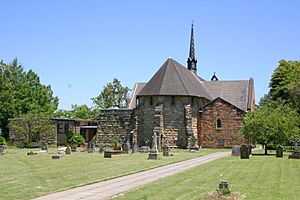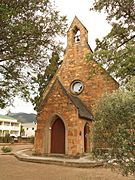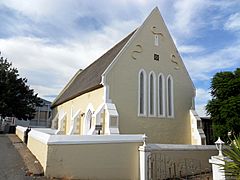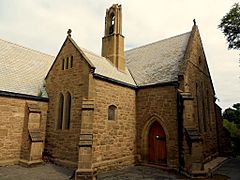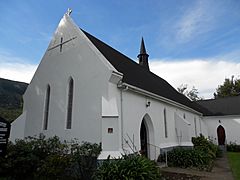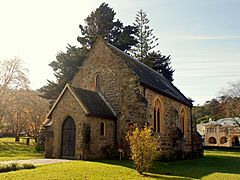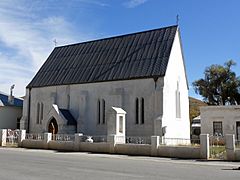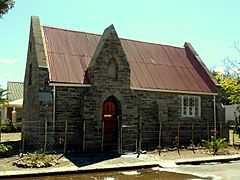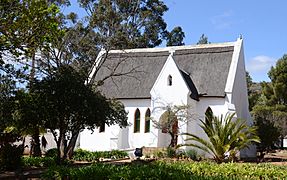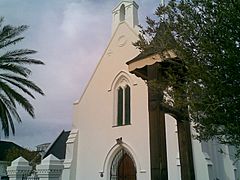Sophy Gray facts for kids
Quick facts for kids
Sophy Gray
|
|
|---|---|
| Born | 5 January 1814 Easington in Yorkshire
|
| Died | 27 April 1871 (aged 57) Cape Town
|
| Known for | Architecture |
Sophy Gray (born January 5, 1814 – died April 27, 1871) was an amazing woman who did many things. She was an artist, a skilled horse rider, and an architect. She also helped manage the church area (called a diocese) for her husband, Robert Gray, who was a bishop in Cape Town.
Sophy was born in Easington, Yorkshire, England. She was the fifth daughter of Richard Wharton Myddleton, a wealthy landowner. She passed away in Bishopscourt, Cape Town and was buried in the graveyard of St Saviour's in Claremont. People who knew her said she was always with her husband on his travels. She helped him with writing and keeping records. She was also a talented designer of churches and made their home at Bishopscourt a happy place.
Contents
Sophy's Early Life in England
Sophy and her two sisters grew up in a rich family. They owned large properties in North Yorkshire and Durham. The girls loved to read and were very good at riding horses from a young age. These interests helped them become good friends with a young man named Robert Gray.
Sophy married Robert Gray in 1836. He was a church leader (called a rector) in Whitworth, County Durham. Their honeymoon was a long trip on horseback, visiting family lands. This trip showed Sophy what her future life with Robert would be like. For nine years, their lives were peaceful. But everything changed when Robert was chosen to be a bishop in a new colony. He was going to the Cape of Good Hope in South Africa.
Moving to South Africa
In 1847, Sophy and Robert traveled to Cape Town. Robert's job was to start a new church area there. He also needed to find more church leaders and build new churches and schools. When they arrived, there were only ten Anglican churches in South Africa. By the time Robert passed away 25 years later, there were 63 churches!
The Grays were used to a fancy lifestyle, like bishops had in England. So, they moved to the Cape with many servants, furniture, and even a special carriage. They settled on a farm called Boschheuvel. This farm was later renamed Bishopscourt and was on the slopes of Table Mountain. It had plenty of water and thick woods.
At Bishopscourt, Sophy started a school for her five children and other children in the area. She used the old slave quarters for the school. Even though she didn't like big social events, she always welcomed church officials and important visitors to their home. She also helped Robert manage his large church area, which included the Cape, Orange Free State, Natal, and the islands of Tristan da Cunha and St. Helena.
Sophy Gray: Architect and Helper
Sophy Gray brought architectural plans of churches with her from England. These plans could be changed to design churches and schools for the new Anglican parishes (church communities) all over South Africa. Both Sophy and Robert liked the neo-Gothic style of church building. This style was popular in Britain at the time.
Sophy was not just an architect. She also kept detailed records of church meetings and official events. She managed all the letters and wrote down the history of the church. Because she was a very good horse rider, she went with her husband on almost all of his long trips. Her artistic skills were clear in the many water-colors and sketches she made. These drawings often appeared in her husband's journals. It was clear that the bishop could not have done his work without her amazing help and knowledge.
There is even a special stained glass window in St George's Cathedral that shows Sophy. In the window, she is wearing a green riding outfit and a hat. She usually wore a simple riding dress with close-fitting riding pants made of Chamois leather underneath.
A researcher named Desmond Martin studied the churches built by the Grays. He found that out of more than 50 churches built in South Africa during Robert Gray's time as bishop, Sophy designed at least 40 of them! In 2005, Martin published a book called "The Bishop's Churches". It shows his water-colors and drawings of Sophy's 40 churches. Some of these include St Paul's in Rondebosch, St Saviour's in Claremont, St Peter's in Plettenberg Bay, St James in Graaff-Reinet, and St Jude's in Oudtshoorn.
Churches Designed by Sophy Gray
| Church | Town | Year | Location |
|---|---|---|---|
| St Paul's Church | Eerste River, Western Cape | 1848 | 34°01′38″S 18°44′40″E / 34.027089°S 18.744493°E |
| St James' Church | Graaff-Reinet | 1848 | 32°15′03″S 24°32′12″E / 32.25090°S 24.53671°E |
| St Paul's Church | Rondebosch, Cape Town | 1849 | 33°57′44″S 18°28′09″E / 33.962111°S 18.469283°E |
| St George's Church | Knysna | 1849 | 34°02′07″S 23°03′01″E / 34.03536°S 23.05027°E |
| School Chapel | Beaufort West | 1849 | 32°20′43″S 22°34′56″E / 32.345383°S 22.582288°E |
| Christ Church | Colesberg | 1849 | 30°43′11″S 25°05′51″E / 30.719813°S 25.097551°E |
| St Mark's Church | George | 1849 | 33°57′28″S 22°27′30″E / 33.95771°S 22.45844°E |
| Holy Trinity Church | Caledon | 1850 | 34°13′54″S 19°25′39″E / 34.231650°S 19.427487°E |
| St Saviour's Church | Claremont, Cape Town | 1850 | 33°59′02″S 18°27′54″E / 33.983850°S 18.464919°E |
| Holy Trinity Church | Belvidere, Knysna | 1851 | 34°02′28″S 22°59′57″E / 34.041186°S 22.999063°E |
| St Peter's Church | Pietermaritzburg | 1851 | 29°36′17″S 30°22′34″E / 29.604722°S 30.376111°E |
| Christ Church | Swellendam | 1852 | 34°01′20″S 20°26′27″E / 34.022280°S 20.440812°E |
| Christ Church | Beaufort West | 1852 | 32°20′45″S 22°34′57″E / 32.3459194°S 22.5824806°E |
| St James, The Great, Anglican Church | Worcester | 1852 | 33°38′45″S 19°26′42″E / 33.645867°S 19.444988°E |
| St John the Baptist Church | Louvain Farm, Schoonberg near Herold | 1853 | 33°48′41″S 22°38′45″E / 33.811265°S 22.645788°E |
| All Saints Church | Somerset East | 1854 | 32°43′01″S 25°35′09″E / 32.717056°S 25.585806°E |
| St Paul's Church | North End, Port Elizabeth | 1854 | 33°56′43″S 25°35′23″E / 33.945341°S 25.589697°E |
| St Matthew's Church | Riversdale, Western Cape | 1854 | 34°05′34″S 21°15′31″E / 34.092683°S 21.258495°E |
| School Chapel | Mossel Bay | 1855 | |
| St Andrew's Chapel | Newlands, Cape Town | 1856 | 33°58′18″S 18°27′16″E / 33.971682°S 18.454575°E |
| Armstrong Memorial Chapel | St. Andrew's College, Grahamstown | 1856 | 33°18′27″S 26°31′07″E / 33.307614°S 26.518481°E |
| St Peter's Church | Cradock | 1857 | 32°10′20″S 25°36′58″E / 32.172248°S 25.616006°E |
| Church of St Mary the Virgin | Woodstock, Cape Town | 1859 | 33°55′36″S 18°26′47″E / 33.926753°S 18.446460°E |
| All Saints Church | Bredasdorp | 1859 | 34°32′06″S 20°02′25″E / 34.535035°S 20.040180°E |
| St Andrew's Chapel | Ceres | 1860 | 33°22′10″S 19°18′39″E / 33.369509°S 19.310847°E |
| St Jude's Church | Oudtshoorn | 1860 | 33°35′15″S 22°12′11″E / 33.5875861°S 22.2031667°E |
| Constantia Chapel | near Cape Town | 1860 | |
| All Saints Chapel | Durbanville | 1860 | 33°50′05″S 18°38′58″E / 33.834707°S 18.649350°E |
| St Mary's Church | Robertson | 1861 | 33°48′05″S 19°52′56″E / 33.801456°S 19.882262°E |
| St Thomas' Mission Station | Rondebosch, Cape Town | 1864 | 33°57′46″S 18°28′37″E / 33.962764°S 18.477080°E |
| St John's Church | Clanwilliam | 1864 | 32°10′44″S 18°53′34″E / 32.1788861°S 18.8928611°E |
| St Mark's Chapel | District Six, Cape Town | 1865 | |
| St Patrick's Church | Umzinto, KwaZulu-Natal | 1868 | 30°18′37″S 30°39′53″E / 30.310278°S 30.664608°E |
| St Augustine's Chapel | Fraserburg | 1869 | 31°55′00″S 21°30′47″E / 31.916598°S 21.513118°E |
| St Luke's Mission Church | Swellendam | 1869 | 34°01′13″S 20°26′40″E / 34.020183°S 20.444433°E |
| St John's Church | Victoria West | 1869 | 31°24′13″S 23°06′45″E / 31.403668°S 23.112632°E |
| All Saints Church | Uniondale | 1869 | 33°39′22″S 23°07′42″E / 33.656098°S 23.128386°E |
| St Mildred's Chapel | Montagu | 1870 | 33°47′13″S 20°07′02″E / 33.787002°S 20.117102°E |
| St Peter's Church | Plettenberg Bay | 1879 | 34°03′16″S 23°22′29″E / 34.054481°S 23.374638°E |
| St Matthew's Church | Willowmore | 1880 | 33°17′44″S 23°29′20″E / 33.295498°S 23.488919°E |
Gallery
See also
 In Spanish: Sophy Gray para niños
In Spanish: Sophy Gray para niños


